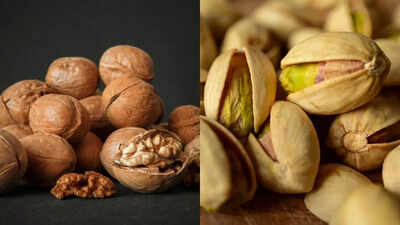Nuts are a popular and nutritious snack, packed with flavor, healthy fats, protein, and essential vitamins and minerals. When choosing between walnuts and pistachios, it's natural to wonder which offers superior health benefits. Both nuts contribute positively to your well-being, but they possess unique strengths.

Both walnuts and pistachios offer a wealth of health benefits, supporting the heart, brain, gut, and overall vitality. They share a similar nutritional profile, however there are subtle differences in their specific contributions to health. A closer look at these distinctions can empower you to make informed choices about incorporating these nuts into your diet.
Here's a breakdown of the key differences between walnuts and pistachios, highlighting their unique advantages for the brain, heart, gut, and overall health:
Pistachios contain a higher amount of protein compared to walnuts.
Protein is essential for muscle building and promoting satiety. If you're seeking a snack that helps you feel full and energized, pistachios might be a better choice.
Walnuts stand out as the only nut with a significant concentration of plant-based omega-3 fatty acids, specifically ALA (alpha-linolenic acid).
Omega-3 fatty acids play a crucial role in supporting brain function, enhancing focus, and boosting memory. Walnuts are therefore an excellent choice for students, seniors, and anyone aiming to optimize their cognitive health.
Both walnuts and pistachios contribute to heart health, albeit through different mechanisms.
Walnuts are rich in healthy fats that help lower blood pressure and reduce inflammation, key factors in maintaining cardiovascular health.
Pistachios, on the other hand, help lower "bad" LDL cholesterol levels due to their high phytosterol content.
Incorporating both walnuts and pistachios into your diet is a smart approach to maximizing heart health benefits.
Pistachios provide a higher fiber content than walnuts.
Fiber is crucial for promoting healthy digestion, supporting gut health, and regulating blood sugar levels. Additionally, pistachios may contribute to a healthier gut microbiome by nourishing beneficial bacteria in the stomach.
Pistachios contain lutein and zeaxanthin, two potent antioxidants that safeguard the eyes and help prevent vision problems like macular degeneration. Walnuts do not offer the same level of these beneficial compounds.
Adding nuts to your meals is a simple and effective way to enhance both flavor and nutritional value. Here are some practical and delicious ideas for enjoying walnuts and pistachios:
Walnuts offer a mild, slightly bitter flavor and a satisfying crunch, making them versatile for both sweet and savory applications.
Pistachios boast a slightly sweet flavor, vibrant green color, and satisfying texture. Eating them in the shell encourages mindful snacking.
Newer articles
Older articles
 Daren Sammy Fined, Handed Demerit Point for Umpire Criticism After Test Match Comments
Daren Sammy Fined, Handed Demerit Point for Umpire Criticism After Test Match Comments
 Gavaskar Calls for Yadav's Inclusion, Questions Middle Order After India's Test Defeat
Gavaskar Calls for Yadav's Inclusion, Questions Middle Order After India's Test Defeat
 Decoding Your Health: Spotting 5 Prediabetes Warning Signs Before a Blood Test
Decoding Your Health: Spotting 5 Prediabetes Warning Signs Before a Blood Test
 X Corp. Cracks Down: Half a Million Indian Accounts Suspended for Policy Breaches
X Corp. Cracks Down: Half a Million Indian Accounts Suspended for Policy Breaches
 Headline:
Early Warning Signs: 5 Heart Attack Symptoms to Watch Out For Weeks in Advance
Headline:
Early Warning Signs: 5 Heart Attack Symptoms to Watch Out For Weeks in Advance
 Facial Icing: Benefits, Risks, and Safe Application of This Viral Beauty Trend
Facial Icing: Benefits, Risks, and Safe Application of This Viral Beauty Trend
 Chess Sensation Praggnanandhaa Joins Magnus Carlsen's Team Liquid for Esports World Cup
Chess Sensation Praggnanandhaa Joins Magnus Carlsen's Team Liquid for Esports World Cup
 Mastering JPG to PDF Conversion: A Graphic Designer's Guide to Quality and Efficiency
Mastering JPG to PDF Conversion: A Graphic Designer's Guide to Quality and Efficiency
 MI New York's Tajinder Dhillon Shines: From IPL Benchwarmer to MLC Star
MI New York's Tajinder Dhillon Shines: From IPL Benchwarmer to MLC Star
 Akmal Blasts PCB's Interim Coach Choice: Ex-Cricketer Questions Logic Behind Mahmood Appointment
Akmal Blasts PCB's Interim Coach Choice: Ex-Cricketer Questions Logic Behind Mahmood Appointment